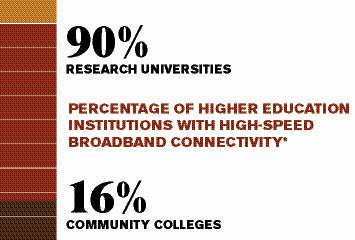Another Digital Divide
Community colleges lag far behind their four-year brethren when it comes to high-speed broadband internet access.
Only 16 percent of community colleges have high-speed broadband connectivity, compared to 90 percent of four-year research institutions. These startling figures were released as part of the National Broadband Plan on March 16th, and they are one reason behind the proposed expansion of the E-Rate program to include community colleges.
 HR 4619, called the E-Rate 2.0 Act, was introduced in mid-February by Representative Edward J. Markey (D, MA), one of the sponsors of the original E-Rate act (which provides funds for internet connectivity to K-12 schools and libraries). In a statement announcing the bill, Markey characterized the explosive growth rate of K-12 classroom internet access—from 14 to 95 percent since the bill’s first passage in 1996—as a direct result of the E-Rate. He wants to see that success replicated for low-income students—in community colleges, Head Start programs, and at home (the bill would provide vouchers to low-income students to purchase residential broadband service).
HR 4619, called the E-Rate 2.0 Act, was introduced in mid-February by Representative Edward J. Markey (D, MA), one of the sponsors of the original E-Rate act (which provides funds for internet connectivity to K-12 schools and libraries). In a statement announcing the bill, Markey characterized the explosive growth rate of K-12 classroom internet access—from 14 to 95 percent since the bill’s first passage in 1996—as a direct result of the E-Rate. He wants to see that success replicated for low-income students—in community colleges, Head Start programs, and at home (the bill would provide vouchers to low-income students to purchase residential broadband service).
The National Broadband Plan supports the expansion of the E-Rate program to two-year colleges in recommendation 11.25: “Congress should consider providing additional public funds to connect all public community colleges with high-speed broadband and maintain that connectivity,” noting the critical role that two-year colleges play in preparing students for careers in teaching as well as science and engineering. “Forty percent of teachers have taken a math or science course at a community college, and 44 percent of science and engineering graduates attended a community college as part of their postsecondary education,” the plan says. “Twenty percent of teachers begin their postsecondary education at community colleges.”
The National Broadband Plan is available at broadband.gov. More information on the E-Rate 2.0 Act can be found at thomas.loc.gov; search on bill number HR 4619.